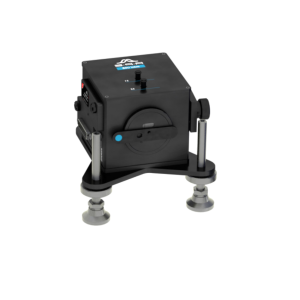Mini PD
Mini PD by APE is the Perfect Combination of Compact Size and A Single Wavelength Range
NIST Traceable Calibration
Laboratories and manufacturers are often faced with systematically establishing an unbroken chain of calibrations to specified references. All APE autocorrelator models are calibrated to a traceable standard in accordance with NIST (U.S. National Institute of Standards and Technology) measurement traceability specifications. A printed and signed calibration certificate is provided with each pulseCheck.
Different Models for Different Wavelengths
The Mini PD is available in a selection of models, each of which covers a different wavelength range, and is ideal for routine tasks where a change in Optics Sets is not necessary.
Compact Design
With its compact footprint of only 160 x 220 x 155 mm, the Mini PD is perfect for working environments where space is limited. When it is needed elsewhere, simply place this portable unit in the lightweight aluminum case provided, for easy and safe transportation to the next site.
Switching Between Collinear and Non-Collinear Mode
The Mini PD supports quick and easy switching between collinear and non-collinear measurement modes. While collinear mode provides pulse width measurement with additional qualitative information about the chirp, non-collinear mode gives background-free autocorrelation with a high dynamic range.
Specifications
At a Glance
| Mini PD Specification | |
|---|---|
| * Measured sensitivity including Optics Set, defined as average power times peak power of the incident pulses P(AV) * P(peak) | |
| Measurable Pulse Width Range | 50 fs ... 3.5 ps; Optional: down to 10 fs |
| Wavelength Range | VIS 1 420 ... 550 nm; VIS 2 540 ... 750 nm; |
| NIR 700 ... 1200 nm; IR 1100 ... 1800 nm | |
| Optics Sets | Not exchangeable |
| Delay Resolution | < 0.001 % of scan range |
| Delay Linearity | < 1 % |
| Sensitivity* | Typically 1 W^2 |
| Recommended Repetition Rate | > 300 Hz |
| Type of Measurement Mode | Non-collinear intensity, collinear interferometric |
| Mode Switching | Yes |
| SHG Tuning for Phase Matching | Software aided |
| Trigger Mode | 300 Hz ... 50 kHz |
| Input Polarization | Linear horizontal, vertical available as option |
| Max Input Power | 1 W (e.g. oscillator with a rep. rate of approx. 70 MHz) or 10 µJ (e.g. amplifed system with rep. rates in the kHz range), whichever results in lower value |
| Input Aperture | 6 mm (free-space) |
| Input Beam Coupling | Free-space; Optional: fiber coupling FC/PC, FC/APC, SMA |
| Beam Input Height | 86 ... 150 mm; Optional 50 mm |
| Software | Included; Real-time display of pulse width and central wavelength, different fitting routines |
| Fitting Routine | Gaussian, Sech2, Lorentz |
| Connection | USB |
| Remote Control | Possible via TCP/IP (SCPI command set) |
| Calibration | NIST traceable calibration certificate included |
- Available in various models, each covering a different wavelength range
- Compact design for minimum space requirements and maximum portability
- Switching between interferometric and intensity autocorrelation
- Ultra-precise delay resolution
- Software-aided phase matching
- Gaussian, Sech2, and Lorentzian fitting routines
- Including software and USB interface
- TCP/IP with standardized command set for easy programming
- NIST traceable calibration
- Aluminium carrying case
Datasheets & Brochures
APE ist ein weltweit führender Hersteller von Laser- und Laserdiagnostik-Instrumenten, insbesondere für die Ultrakurzpuls-Diagnostik (u.a. Autokorrelatoren) und die Wellenlängen-Konversion (u.a. Abstimmbare Laser, OPO, OPA). Unsere Kunden arbeiten in verschiedenen Anwendungsgebieten von der Spektroskopie bis zur Mikroskopie, von der Quantenphysik bis zur Lasermaterialbearbeitung. Wir sind ein 1992 gegründetes mittelständisches Familienunternehmen mit Sitz in Berlin.
Zur Verstärkung unseres Teams suchen wir zum nächst-möglichen Zeitpunkt eine/-n ambitionierte/-n
Prüffeld-Elektroniker (m/w/d)
Ihre Aufgaben
- Inbetriebnahme elektronischer Geräte
- Elektrische Inbetriebnahme elektronischer und elektromechanischer Baugruppen (z. B. bestückte Platinen oder Motor-Baugruppen)
- Reparatur, Fehlersuche, Fehlerbehebung, Upgrade o.g. Geräte und Baugruppen Nutzung vorgefertigter Prüfprotokolle, aber auch deren Aktualisierung und Erweiterung
- Erstellung neuer Prüfprotokolle in Zusammenarbeit mit der Entwicklungsabteilung
- Nutzung von Standard- Software und eigenen Software-Tools auf dem PC
- Selbständiges Arbeiten mit dem ERP-System von APE
- Fertigung (Löten und Montieren) von elektronischen und elektromechanischen Baugruppen
Was Sie mitbringen sollten
- Abgeschlossene Berufsausbildung als Elektroniker, Mechatroniker oder gleichwertig
- Sicherer Umgang mit den für Elektroniker üblichen Mess- und Prüfmitteln
- Erfahrungen beim Bestücken von Leiterplatten gewünscht
- Gute elektronische und technische Kenntnisse
- Kenntnisse im Umgang mit ERP-Systemen wünschenswert
- Zuverlässige, selbstständige und strukturierte Arbeitsweise
- Sprachkenntnisse: Deutsch fließend, Englisch von Vorteil
Wir bieten
- Eine Herausforderung mit Eigenverantwortung in einem hochtechnologischen Umfeld mit familiärer Arbeitsatmosphäre
- Eine vielseitige Tätigkeit in abteilungsübergreifender Teamarbeit
- Ein motiviertes, kollegiales Team mit flachen Hierarchien und kurzen Entscheidungswegen
- betriebliche Altersvorsorge
- Deutschlandticket-Job
Wenn Sie Freude daran haben, innerhalb eines expandierenden mittelständischen Unternehmens in der Metropole Berlin in einem freundlichen und kollegialen Umfeld zu arbeiten, freuen wir uns auf Ihre Bewerbung.
Ihre vollständigen Bewerbungsunterlagen schicken Sie per Email an:
Cornelia Gläser
cornelia_glaeser@ape-berlin.de
APE Angewandte Physik und Elektronik GmbH
Plauener Str. 163 - 165, Haus N
13053 Berlin
Tel.: 030-98601130
Step Files (.stp)
APE-Mini-Stepfile-20150921 (.stp 3D CAD model with overall dimensions)
TCP/IP Sample Code for Remote Control
or
Email & Phone Contacts
APE has distributors around the world to give you the best support. Choose a country to find your local sales contact:
More is More
Working with the pulseLink Controller (applicable to Mini PD, Mini TPA, pulseCheck)
Acquisition Software and TCP/IP Standard Software Interface
All models come with an easy to use data acquisition software, allowing for real-time data display. Furthermore, the TCP/IP-based standard software interface by APE makes it straight forward to set up remote control. This allows you, for example, to design your own automated measurement routines. Simply use our protocol templates for rapid configuration with familiar programming languages, including C++, C#, LabVIEW, Python, Matlab, and Ruby.



